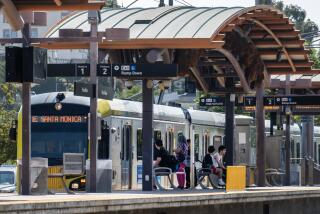More People Use Public Transit, While Putting Pressure on Systems
- Share via
WASHINGTON — From Gainesville, Fla., to Grand Central Terminal, the number of people crowding onto public transportation is the largest in 40 years. The surge has packed trains and buses, crammed park-and-ride lots and suggests that increasingly, Americans are leaving the driving to someone else.
Last year, 9 billion trips were taken on mass transit in the United States, according to new figures released by the American Public Transportation Assn. here. The last time ridership was that high, Dwight D. Eisenhower was in the White House.
More significant, transit advocates say, is that ridership is rising at a rate faster than automobile use. Ridership rose 4.5% in 1999 compared with 1998, while motor vehicle travel rose 2%, according to the transit association.
The shift is putting a stress on some transit providers as passengers flood through turnstiles and squeeze onto standing-room-only buses.
Highway advocates noted that although transit ridership is increasing, the vast majority of Americans still relies on the automobile for trips to work and play.
“Let’s not break out the champagne here,” William D. Fay, president of the American Highway Users Alliance, said in response to some transit officials’ giddiness over the new numbers. “Highway growth is the real success. By real numbers, far more people are driving cars than taking transit.”
In the last year, transit gains have been visible from Bowling Green, Ky., where bus ridership increased 31%, to New York City, where ridership on buses, commuter trains and the nation’s largest subway system jumped 7%.
“Transit dominated this country prior to World War II,” said Richard A. White, Washington’s Metro general manager. “After the war, that changed with the creation of the interstate system and tremendous exurban and suburban development. But now that congestion and sprawl are becoming front-burner issues, there’s a change in people’s attitudes and patterns.
“This is a harbinger of good times.”
Public transit use peaked in 1946, when Americans took 23.4 billion trips on trains, buses and trolleys, said Donna Aggazio, spokeswoman for the American Public Transportation Assn. By 1960, that figure had dropped to 9.3 billion, and it declined further as roads and car culture gripped the nation. In 1972, transit ridership hit rock bottom at 6.5 billion trips. Since then, it seesawed until 1995, when it began steadily climbing.
Transit operators and analysts say increases in mass transit ridership are driven by several factors, including heavy public spending on transit, a strong economy, stable fares, innovation among transit systems and growing congestion on roads and highways.
The federal government began heavily investing in mass transit about 10 years ago, sending billions of dollars to communities across the country to launch ferry boats, build tracks and buy trains and trolleys, including special vehicles for the disabled. Meanwhile, many states increased transit funding.
“If you invest in something and provide a good product, people will use it,” said Chris Boylan, spokesman for the Metropolitan Transportation Authority, which operates the New York City subway and bus system as well as Long Island Bus and two commuter railroads. The MTA has spent $34 billion in improvements since 1982, he said. Daily trips number 7.2 million today, compared with 5.1 million three years ago, Boylan said.
Heavy spending on transit is likely to continue.
A rollicking national economy also has boosted ridership. “People ride for a purpose, either making money or spending money,” said William Millar, president of the American Public Transportation Assn.
The economy has allowed fares to remain relatively flat while enabling transit agencies to offer new service or extend existing service, he said. Salt Lake City just opened its first rail system, Phoenix is adding Sunday bus service, and Colorado voters have decided to extend Denver’s light-rail system.
Many say the transit agencies have attracted riders by becoming more flexible and creative. “The industry has gotten a lot smarter,” said Bruce Frame, spokesman for the Federal Transit Administration. In Baltimore, after the transit agency rolled out a $3 transit pass for unlimited one-day travel on trolleys and buses, ridership jumped, said Frame, who lives there.
Several transit agencies have been offering up-to-date transit information through Web sites or station signs.
A new trend in transit, called universal access, also is proving highly popular, Millar said. Universal access gives passengers unlimited rides on a transit system in exchange for a flat fee that is usually paid by a third party--a university or housing complex or community, he said.
In State College, Pa., bus ridership shot up 250% last year after Pennsylvania State University gave $1 million to the local transit agency to get rid of 40-cent fares and offer unlimited, free travel on routes connecting the campus with downtown, said Hugh Mose, general manager of the Centre Area Transportation Authority.
“This fall we won’t have enough equipment,” Mose said. The agency had ordered 10 new buses and just bought six more. Even so, Mose expects to come up short.
Although some say rising fuel prices may have shifted some riders from cars to mass transit, several transit agencies reported ridership already was going up last year when gasoline prices were still less than $1 a gallon.
Meanwhile, sprawl and traffic congestion are making automobile travel less appealing, said Alan Kiepper, a transportation consultant who has run the transit systems in Houston, Atlanta and New York. “Congestion is just getting really, really bad, and people are sick of sitting in their cars and getting nowhere,” he said.
More to Read
Sign up for Essential California
The most important California stories and recommendations in your inbox every morning.
You may occasionally receive promotional content from the Los Angeles Times.













